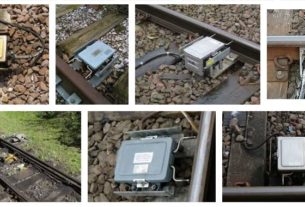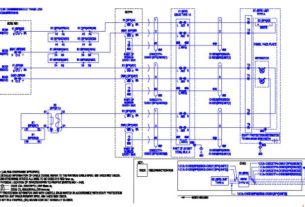Railway Track Locking Distance
The distance between the track circuit block joint and the tips of the switches is known as the track locking distance and is marked as ‘X’ on.
shows the track locking contact incorporated in the point circuit.
The track locking distance will vary according to the type of track circuit, point mechanism used and the speed of an approaching train.
The minimum acceptable distances for Track locking are laid down in Engineering Standard E7204 and are as follows:
Facing passenger moves: 20m
Facing shunt moves: 10m
Trailing moves: 3m
Assuming that the layout in involves a passenger move, if the distance ‘X’ is greater than or equal to 20m, the points have sufficient track locking.
If these distances cannot be achieved then the points are said to have insufficient track locking.
Overcoming Insufficient Track Locking Distance
If there is an insufficient track locking distance, this can often be overcome by including an ‘Up’ contact of the track circuit prior to the track locking track. This contact is included in the point lever lock and ground lock control circuitry as shown in Fig.
Fig 7.3 shows the distance marked ‘Y’ is less than 20m, the addition of DB track increases it to 40m, marked ‘X’, which is now sufficient.
In certain circumstances, adding the previous track circuit to the track locking may cause problems.
It can be seen in Fig 7.5, signal PM1 is very close to 6’s points which due to its insufficient track locking distance, would need to include the previous track relay (DB TR) in its lever locking circuit as shown in Fig 7.6.
If a train were berthed at signal PM1, it would be track locking 6’s points ahead. This would prevent them from being thrown Reverse in order to set up PM1 route 2.
Clearly this is not a flexible application of track locking.
One way of overcoming this problem is to add a track circuit (DB) 100′ (30.5 m) long, in front of the track locking track as shown in Fig 7.7.
If a train can be proven to be moving very slowly or stationary, then the extra track circuit (DB TR) can be bypassed to allow the signalman to throw the points. This can be achieved by timing how long it takes for the train to travel over the extra track using a time delay relay as shown in Fig 7.8.
When the train shunts DB track, the time relay (6JR) starts to wind. If the train is moving at an acceptable speed it will travel the length of DB track in less than 15 seconds. The train should therefore be stationary at the moment the time relay (6JR) is fully energised and its front contact makes.
Once the train has been proved stationary, the extra track locking can be by-passed using a contact of the associated JR as shown in Fig 7.9. This then allows the points to be thrown for PM1route 2
If the train were travelling too fast, it would complete the timing section before the relay timed out and would then be occupying DD track circuit (having possibly been tripped at PM1 signal). With this track relay contact broken (DD TR) the lever lock and WL valve would remain de-energised even after the JR had picked up. In this situation the train would have to pass through route PM1 under rule before the points could be released.
In the above situation the minimum track locking distance is maintained by the front contact of DB track relay. If the parallel JR contact were to remain closed due to the relay being mechanically stuck up, this distance would be compromised.
To protect against this eventuality, the JR is down proved (Fig 7.10) in the signal selection of the signal to the rear of PM1. If the JR did become mechanically stuck up, the previous signal would fail to clear and therefore prevent a train from entering an area where the integrity of the signalling cannot be guaranteed.








